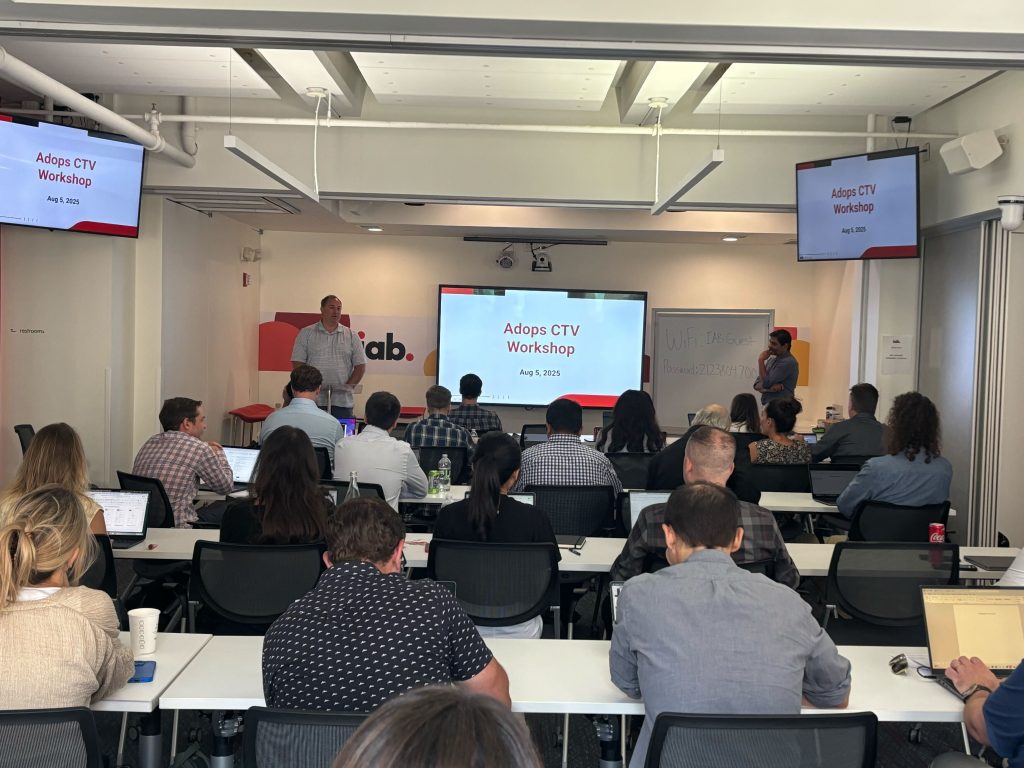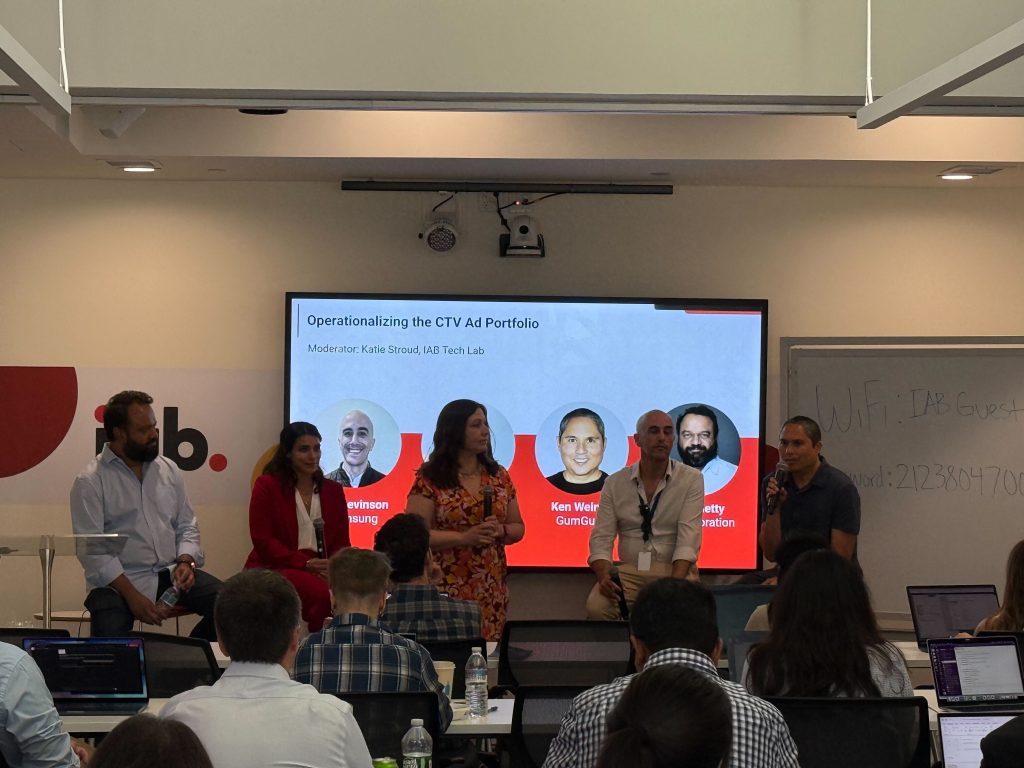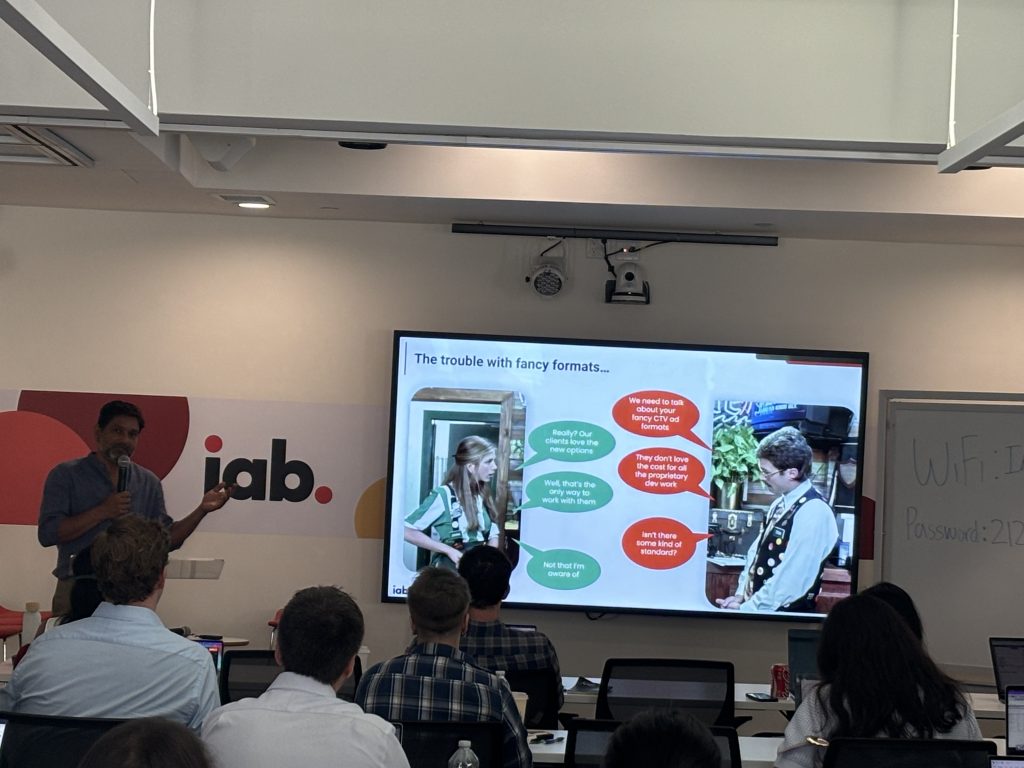Key Takeaways from the IAB Tech Lab CTV Ad Ops Workshop
The IAB Tech Lab CTV Ad Ops Workshop brought together experts from across streaming, ad tech, and television to examine the challenges, innovations, and opportunities in connected TV (CTV) advertising.
IAB Tech Lab would like to thank the participants for their time and expertise – Steven Ware-Jones (Meta), Amit Shetty (Fox), David Sidman (Videostorm), Stephen Walcher (AD ID), Ken Weiner (GumGum), and Chris White (Google).
During the course of the workshop, which brought together operations professionals from brands, ad tech platforms, agencies, resellers, and publishers, including Paramount, NBC, DirectTV, Samsung, Fox, Disney, Yahoo, and many more, a number of areas for further innovation, education, discussion, and industry action became clear.


Clear Standards for Advanced Ad Formats Are Essential
There was general agreement that CTV growth will be accelerated only when advanced ad formats can be executed consistently across platforms. IAB Tech Lab’s COO, Shailley Singh, presented a recap of the Ad Format Hero initiative that is intended to be a pathway to prescribing standards for CTV-focused ad executions that are broadly accepted—even if that requires certain compromises on “bells and whistles.”
Without clear specifications, execution varies widely. Advanced ad experiences such as image overlays, L-Bars, squeeze-backs, and shoppable ads often depend on proprietary methods. While standards supporting many of these capabilities exist, such as Version 4 of VAST and SIMID (Secure Interactive Media Interface Design),which replaced VPAID, adoption is low. This creates a barrier to these formats reaching the necessary programmatic scale for both buyers and sellers to benefit. One participant discussed a real world scenario demonstrating this, where in some cases, multi million dollar orders become difficult to execute efficiently as a result of this lack of adoption.
Live Event Advertising Requires Specialized Solutions
Live programming, particularly sports, presents unique ad-serving challenges. The current process involves intervention from on-site production trucks, with technical staff triggering ads during breaks which kicks off a highly complex process required to serve millions of concurrent streams programmatically.
The Live Event Ad Playbook (LEAP) was introduced by Hillary Slattery, who leads the initiative from the Tech Lab side, as a multi-pronged solution, incorporating the Concurrent Streams API (released), the Forecasting API (upcoming), and future capabilities for pre-fetching bids. These steps aim to reduce latency and network strain during high-volume live events, enabling transacting at scale so that sellers can maximize their revenue from these valuable opportunities, and buyers can take advantage of this high engagement programming.
Feedback Loops Coming to CTV Through a Universal CAPI
In most TV environments, publishers have no visibility into how the viewer interacts with the brand after seeing an ad. Proprietary Conversion APIs (CAPI) exist in some platforms, enabling advertisers to share conversion data—such as signups, downloads, or purchases—back to publishers.
The development of a universal CAPI standard for TV was highlighted as a priority to give publishers the insights needed to optimize inventory and measure campaign effectiveness, in the same way that CAPIs from the likes of Meta, Google, and TikTok have enabled optimization of demand on their platforms.


Universal Creative IDs are Transforming Ad Tracking
The Ad Creative ID Framework (ACIF) was compared to retail barcodes for its potential to uniquely identify each ad in a CTV environment, and the progress it has made since last year was discussed. A major part of that progress was the introduction of the ACIF Validation API, through which creative IDs can be verified, and related metadata can be retrieved from ad registries. AD-ID demoed their implementation of the API to the group. Other countries have their own unique ad registries, with several discussing joining the Framework and adopting the API.
Adoption challenges remain, including determining who is responsible for registering ads, ensuring IDs remain attached through the supply chain, and preventing spoofing. Embedding IDs in audio watermarks was discussed as a solution to preserve ID integrity, though this too requires standardization.
Watermarking was identified as a potential tool to embed universal creative IDs directly into ad assets, enabling easier tracking, attribution, and fraud prevention. The technology exists today but is not standardized, and IDs used in watermarking are not yet universal. The standardization of watermarking tied to ACIF is seen as a potential avenue for increasing adoption, but requires coordination across the industry to determine if it will be the most straightforward solution, or have the same process challenges that ACIF has experienced.
Better Metadata and Taxonomy Are Needed for Inventory Management
In several of the discussions, workshop participants emphasized the need for consistent use of signals such as ratings, genre, and content IDs, along with richer taxonomy values, including sentiment analysis at the moment an ad is served. Such enhancements would improve targeting precision and inventory quality. While the IAB Tech Lab-managed taxonomies help, many companies are still using free form text versions or older taxonomies that are not fit for purpose, despite the release of mappings to help with migration to more robust later versions.
It was clear, however, that these capabilities must be developed with caution due to privacy considerations. A level of concern around the balance between user privacy and content level transparency on both the buy and the sell side that future innovation will hopefully be able to mitigate.
CTV Inventory Ownership Is Complex and Unclear
Another area of complexity that was highlighted throughout the workshop was around inventory right of sale in CTV. In traditional web video, the “publisher” typically controls the player, content, and site or application. In CTV environments it’s not so simple. Right of sale is distributed across any one or more of the content provider, distributor, OEM (Original Equipment Manufacturer), TV platform, and app owner. This fragmentation has created uncertainty over who truly “owns” the ad inventory.
Although Tech Lab does not set business models, the programmatic ecosystem may require that ad revenue splits be made explicit at the time of ad placement. Without clarity, automation becomes difficult, and models may need to differ from those used in web or mobile advertising. Ads.txt, App-ads.txt, and the supply chain object do, in fact, bring transparency into which parties are authorized to sell the inventory, but the way that some platforms interpret the complexity of these relationships can lead to unexpected outcomes, especially for resellers. Additional guidance in the future was thought to be helpful in this area.
What Comes Next?
The workshop reinforced the urgent need for alignment on CTV advertising standards. From clarifying inventory ownership to streamlining live event delivery and enabling universal creative IDs, progress depends on active industry engagement.
Stakeholders are encouraged to participate in ongoing IAB Tech Lab initiatives to ensure that solutions are developed with operational realities in mind. IAB Tech Lab members in this ecosystem are encouraged to join the Advanced TV Working Group, or even the Advanced TV Commit Group and to bring proposals to the table to solve these issues. If you are not a member, and want to help solve these problems, then what are you waiting for? Email memberships@iabtechlab.com today! We’ll also be covering many of these issues, and more, in greater detail in NYC on December 4 at I Want my CTV 2025: Stream Big or Go Home.

Barnaby Edwards
Sr Director, Product Marketing
IAB Tech Lab